14 2 5 3 Alpine Nature 2030 Creating ecological connectivity for generations to come 89 For effective participatory processes it is very important to be clear on the why what who and how much of participation from the initial plan ning stages through to the implementation and follow up stages of any initiative that requires broad often trans sectoral support Unfortunately there are numerous reports on the dif culty of involving stakeholders from key sectors in meaningful ways in nature protection activities The institutional frameworks within which such processes are to be carried out may or may not be adequate and there must be a genuine willingness to make use of stakeholder contributions so that participation does not end up being a perfunctory exercise The quality of decisions made through stakeholder participation depends a lot on the nature of the process leading up to them Reed 2008 Organisational cultures can hinder or facilitate participatory processes they have to be able to accept and process the negotiated goals and uncertain outcomes of the stakeholder participation process Truly participatory processes entail the inher ent risk that the outcomes will not be those desired by the project management authorities Participation is costly and takes time and some groups that lack skills or resources to participate may end up being excluded Nared et al 2015 There are also examples in the literature where community participation was attempted but resulted in negative outcomes for the project proponents or where the circumstances made a participatory approach less than ideal Irvin and Stans bury 2004 Furthermore to identify the most relevant stakeholders an in depth knowledge of the situation is needed A stakeholder analysis must precede any such process Depending on the setting a variety of tools for such analysis exist Reed 2008 3 2 1 Deªcits in trans sectoral stakeholder involvement It has been widely con rmed that a participatory ap proach that integrates sustainability criteria that is a balance of ecological economic and socio cultural fac tors tends to lead to the best results Torre Marín et al 2012 This applies to all projects but especially to bio diversity conservation and initiatives for the preserva tion or restoration of ecological connectivity which by their very nature require an integrated trans sectoral approach Yet current political and legal systems are not designed to effectively deal with this complexity In order to be successful organisations or projects im plementing biodiversity strategies therefore necessarily have to be very creative in identifying and motivating key stakeholders who can help or hinder project suc cess to participate in the decision making processes The proponents of nature protection projects often nd it dif cult to involve stakeholders from a mix of all sectors that have an impact on biodiversity and ecosystems For some sectors such as agriculture forestry and sheries there is a direct dependence on functioning ecosystems and the services they provide while activities in those sectors also tend to have an immediate impact on ecosystems Depending on how these activities are carried out the effects on biodi versity can be both positive and negative The tourism sector in the Alpine region bene ts from landscape beauty and often uses this as a selling point but tour ism is also frequently though again not necessarily a contributor to habitat disturbance fragmentation and loss Other sectors such as energy transport and infra structure tend to have a large impact on ecosystems for example through habitat loss and fragmentation and pollution The dependence of these sectors on ecosystems is less obvious These individual and mark edly different sectors sometimes have con icting goals and it is therefore dif cult to implement trans sectoral biodiversity policies This is compounded by dif culties in motivating stakeholders from these key sectors to collaborate in valuing and protecting ecosystems and their services Land use planning should by default be trans sectoral but the local realities of spatial planning are fraught with dif culties Based on expert surveys the greenAlps project co nanced by the ETC Alpine Space Programme identi ed important stakeholders and key actors that im pact biodiversity conservation ecological connectivity and the provision of ecosystem services in the Alpine region Svadlenak Gomez et al 2014 The analysis showed not surprisingly that the very important stakeholders with power and political interests politi cians ministries and more appear to be more dif cult to involve than those with knowledge and interest academic researchers experts NGOs and more Many survey respondents criticised a lack of coordination between different sectors Responses concerning the frequency of contacts among nature conservation stakeholders showed that most people primarily com municate within their own peer group that is experts have contact with experts academics with academics NGOs with NGOs and more stakeholders from different

Hinweis: Dies ist eine maschinenlesbare No-Flash Ansicht.
Klicken Sie hier um zur Online-Version zu gelangen.
Klicken Sie hier um zur Online-Version zu gelangen.